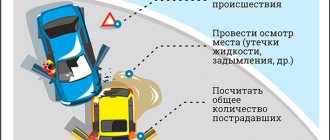How to file a traffic accident?
If the following conditions are met, then the accident can be registered using a European protocol:
- damage in the accident was caused only to vehicles and there were two of these vehicles,
- both drivers agree with the circumstances of the accident and the list of visible damage to the cars,
- there were no injuries or fatalities in the incident,
- The liability of both drivers is insured under MTPL (there are valid MTPL policies).
To do this, it is necessary to fill out the notice together, with each driver signing both sheets of the notice on the front side. Each of the participants in the accident fills out the back side themselves.
If at least one of the above conditions is not met, if there are victims or damage to other property is caused, then traffic police officers must handle the registration of the accident. They record all the circumstances and issue documents with which the victim will go to the insurance company.
Sometimes so-called emergency commissioners arrive at road accidents. These are not traffic police officers and they do not have the right to register an accident, but there is apparently some kind of agreement between the traffic police officers and these commissioners, so the latter record the circumstances and then transfer the materials to the traffic police.
You can entrust the registration to emergency commissioners only at your own peril and risk... If, when registering an accident, they indicate something or do something incorrectly, there will be no one to ask.
Likewise, if they lose or do not transfer the material to the traffic police, then registering the accident again will be extremely problematic, sometimes even impossible. Sometimes commissioners are not shy about demanding money for their work, so decide for yourself in advance whether, in the event of an accident, you will trust them or insist on the arrival of police officers.
What documents are needed to apply for compulsory motor liability insurance?
The set of documents for the insurance company will depend on what kind of accident there was and how it was processed.
A complete list of them in case of damage to the property of victims is indicated in clause 3.10 and clause 4.13 of the Insurance Rules. The victim whose accident was registered according to the European protocol will have the most minimal set. This:
- application for payment
- accident notification,
- passport of the beneficiary (owner) of the car,
- as well as documents confirming ownership of the car (most often an STS is suitable, but formally this is a purchase and sale agreement).
Those victims whose accidents were registered by police officers will also have to provide:
- a copy of the administrative violation protocol,
- resolutions in a case of an administrative offense or rulings on the refusal to initiate a case of an administrative offense.
And those who were injured in an accident and their health was harmed are forced to collect the largest set of documents, since it will be necessary to provide medical documents:
- certificates from a medical organization,
- conclusion of a forensic medical examination,
- documents in case of loss of earnings and in some cases other documents.
A complete list of these documents can be found in Chapter 4 of the Insurance Rules.
What documents must be submitted for the payment period to begin?
Important! Didn't receive an answer to your question? Our expert lawyers work for you. It's absolutely free!
- Only practicing traffic lawyers
- Anonymously
- For free
or call toll free number 8
✖
The package of documents required for payment is not very large. It is declared in Article 30 of the Law “On Compulsory Motor Liability Insurance” and includes:
- application for insurance payment (usually written on a form when contacting the insurance company);
- a resolution from the traffic police issued to the other participant(s) in the accident or a ruling refusing to initiate a case;
- certificate of accident (issued by the traffic police);
- SoRTS - vehicle registration certificate (erroneously called by many “registration passport” - pink plastic that you always carry with you) or PTS in the absence of SoRTS;
- notification of an accident;
- OSAGO policy.
This is an exhaustive list of documents that you are obliged to provide to the insurance company, and the insurance company has no right to demand other documents from you (part 8 of article 30).
What is the deadline for applying for payment?
In the Law on Compulsory Motor Liability Insurance, current for 2021, the deadline for filing an application is specified only for the case of registration of an accident under the European protocol - as soon as possible, but no later than five working days after registration of the accident. But violation of this deadline cannot be the reason for refusal of insurance compensation. Therefore, we can say that in general, the period for contacting an insurance company is not strictly regulated.
You should rely only on the statute of limitations, which will begin to count from 21 days after contacting the insurance company with a full set of documents, and which is 3 years.
And in cases of harm to the life and health of the victim, there is no statute of limitations for contacting the insurer under compulsory motor liability insurance.
According to Art. 208 of the Civil Code of the Russian Federation, the statute of limitations does not apply to claims for compensation for harm caused to the life or health of a citizen.
But all of the above is rather applicable in some exceptional cases, because each of us will try to receive compensation for damage as quickly as possible, because even by contacting the insurer as soon as possible, you can wait for payment for a year or even more, but we will talk about this further .
What is the payment period for compulsory motor liability insurance for an insurance company?
The Federal Law “On Compulsory Motor Liability Liability Liability Liability Liability Insurance” clearly defines the terms of payment under compulsory motor liability insurance in case of an accident. Article 12.21 states that the insurer is obliged to consider an application for compulsory motor liability insurance from the driver within 20 days from the date of its receipt. After its delivery, the organization is given 15 days to receive the document, the remaining 5 days are given to draw up a report on the occurrence of the insured event.
The insured event report serves as the basis for making a decision to refuse or to make an insurance payment to the victim. If the decision is positive, the victim’s car may be sent for restoration work or monetary compensation may be paid. Today the first option is a priority.
If, after studying the case, the insurer decides to refuse compensation, it must notify the motorist in writing, indicating the reasons. The refusal can be partial or complete.
Can I contact my insurance company?
You can not only contact your insurance company, but, more often than not, you even need to contact them exclusively. Based on the number and nature of accidents that occur in our country, most often they meet the requirements for direct compensation for losses.
The victim makes a claim for compensation for damage caused to his property to the insurer who insured the civil liability of the victim, if the following circumstances exist simultaneously:
- a) as a result of a traffic accident, damage was caused only to the vehicles specified in subparagraph “b” of this paragraph;
- b) a traffic accident occurred as a result of the interaction (collision) of two or more vehicles (including vehicles with trailers), the civil liability of the owners of which is insured in accordance with this Federal Law.
In other cases, you should contact the culprit's insurer. And in some cases, victims have to apply to the RSA for compensation.
What to do if your payment was refused or you paid little?
It is possible to sound the alarm already 21 days after the day of submitting the full set of documents to the insurer, but it is not entirely correct. The insurer has every right to send you a referral for repairs in a simple letter, via mail, and doing this on the 19th day of the term will not violate anything. Therefore, it is best to wait at least 7 days, in case a letter was sent to you, and only then start a dispute with the insurer.
Before calling, writing or going to the insurer, we strongly recommend that you carefully read and study the following materials: Article 16.1 of the Law on Compulsory Motor Liability Insurance and our article about the financial ombudsman.
Do not forget that compulsory motor liability insurance currently represents “partial insurance”, that is, even if the insurer calculates and evaluates everything correctly, the payment made to you or the service station may not be enough for repairs. In this case, the remaining damage must be recovered from the culprit of the accident.
What are the maximum payments in 2021?
They are regulated by the Federal Law on Compulsory Motor Liability Insurance FZ-40, and today there are 3 of them:
- the maximum amount of compensation for damage to cars and other property is 400,000 rubles,
- if the accident is documented in a European protocol, then the maximum amount of payment under compulsory motor liability insurance is reduced to 100,000 rubles (but under certain conditions the same 400 thousand remains),
- The upper limit of liability for damage to the health or life of victims of an accident is 500,000 rubles.
So, let's look at all the options for such amounts in order and the subtleties of their calculation!
Will I receive a payment or repair?
In 2021, for individuals whose vehicle is registered in the Russian Federation, priority has been established for in-kind compensation for damage (repairs at a service station) rather than payment of the cost of restoration repairs in cash.
But there are exceptions in which the insurer is obliged to pay in cash. This happens in the following cases:
- complete loss of the vehicle;
- death of the victim;
- causing serious or moderate harm to the health of the victim as a result of an insured event (must be indicated separately in the application);
- if the victim is a disabled person specified in paragraph one of paragraph 1 of Article 17 of the Law on Compulsory Motor Liability Insurance (must be indicated separately in the application);
- if the cost of restoration repairs exceeds the limits of 400,000 and 100,000 rubles, depending on the method of registering the accident;
- if, in accordance with paragraph 22 of the Law on Compulsory Motor Liability Insurance, the fault is recognized as mutual, and the participants in the accident do not agree to pay extra at the car service center;
- if the car service does not meet the requirements for repairing your car (for example, the insurance company does not have contracts with official dealers, and your car is less than 2 years old);
- if the insurer cannot organize repairs at the station that the victim chose when concluding the MTPL contract and the victim does not agree to have the car repaired at another station;
- existence of a written agreement between the insurer and the victim (beneficiary).
Read more about the choice between payment and repair in our previous article: Repair or money: who chooses, the insurance company or the car owner, and which is better?
Terms of payments under compulsory motor liability insurance in case of an accident
When the injured motorist submits an application for compensation and all the required documentation to the insurance company, the deadline for compulsory motor liability insurance begins to count, during which the company is obliged to make a decision: make a cash payment, send the car for repairs, or refuse to cover the costs. Holidays and weekends are not taken into account. This says that we are talking about calendar days.
If the 20-day period has expired, you should contact your insurance company and find out the reason for the delay. If the driver considers these arguments unconvincing, he can submit an application for payment of a penalty under the motor vehicle license. For each day of delay, the penalty is 1% of the amount of damage. So, if, according to the results of the examination, the amount of damage is 120 thousand rubles, then in just 5 days of delay the client will receive an additional 6 thousand rubles.
The legislation provides for the possibility of filing a complaint against an insurance company with the FSSN and RSA. If they do not help, then you can send a claim to the insurance organization describing your requirements. 10 days are provided for its consideration. During this time, the company can provide the following:
- make a payment;
- issue a direction for restoration work;
- refuse reimbursement of expenses.
Russian legislation regulates the periods during which the insurer is obliged to make monetary compensation or issue a referral for restoration work.
Agreement between the insurer and the victim
Separately, it is necessary to tell you about this particular case of monetary compensation, since insurers, taking advantage of the inattention of the victims and their lack of a complete understanding of the situation, are inclined to sign agreements that are often not beneficial to the victims.
Read carefully what you are asked to sign. The agreement can be either simply to replace the method of compensation from repairs to a cash payment, or an agreement to pay a specific amount that is specified in this agreement.
If the form of compensation is changed from repair to payment, everything is more or less “safe”, the insurer inspects the car, calculates the damage and makes a payment, everything is as it was before.
The most interesting thing is when the insurer offers to sign an agreement indicating a specific amount of insurance compensation . He indicates this amount based on the inspection of the vehicle. But this does not mean that the agreement indicates the full amount of damage that was calculated.
Often, insurance companies inspect cars superficially, without disassembling or examining hidden damage.
- After such an incomplete inspection, you will not even know the entire list of damage to your car, not to mention the full amount of restoration repairs.
- After such an inspection, the agreement does not indicate the full amount of damages that you agree to. And by signing such an agreement, you waive further claims against the insurer; there will definitely be a clause about this in the text of the agreement.
As a result, you may receive only a small part of the insurance compensation, which will not be enough to repair the car.
It is very difficult to challenge this agreement in court in 2021, but it is possible... You need to recognize such an agreement as invalid and prove that the insurer conducted an incomplete inspection of the vehicle and did not indicate all the damage, as a result of which you could not adequately assess the damage and make the right choice.
The largest players in the MTPL market, such as Rosgosstrakh, Ingosstrakh, Alfa Insurance, RESO - almost all insurance companies actively pay out insurance compensation in cash with the signing of agreements, so carefully read the papers that you are given to sign and do not make rash decisions. It’s better to take a break and consult a lawyer.
How to receive payment in lieu of repairs?
If your insured event does not fall under the above exceptions to the general rule, and an agreement to pay you was either not offered, or it is unprofitable, then these are not all the ways you can get a payment in money.
The victim has the right to change the form of insurance compensation from repair to cash payment if the insurer or station violates his rights.
Remember how long the insurer is given to issue a referral for repairs, that’s right, 20 days. If the deadline has passed and there is still no direction, is the victim obliged to wait until the Investigative Committee deigns to organize repairs - no. In this case, the victim has the right to demand payment in money.
If the insurance company sent the referral within twenty days, but it arrived outside this 20-day period, then you are obliged to provide the car to the service station, and within the period specified in the referral.
If the period specified in the direction has already expired while the letter was being sent or is about to expire, and you do not have time to return the car to the service station, then you are obliged to provide the car for repairs within a reasonable time after receiving this direction. This was indicated by the Supreme Court of the Russian Federation in paragraph 60 of the Resolution of the Plenum of the Supreme Court of the Russian Federation No. 58 of December 26, 2021.
If your service center does not accept the car for repairs, and the 20-day period has already passed, and the insurer cannot issue you a new referral, then you also have the right to demand payment in money.
They may accept the car, but require additional payment for repairs, since the amount agreed with the insurer is clearly not enough for normal repairs. You have the right to refuse the additional payment, whatever it may be, and receive payment of the insurance compensation in cash.
It is still possible that the car will be accepted for repair and no additional payment will be required. But the repairs will not begin. In this case, if the service station does not begin timely restoration repairs or performs repairs so slowly that completing it on time becomes clearly impossible, the victim has the right to change the method of compensation for damage and demand payment of insurance compensation in the amount necessary to eliminate the defects and complete restoration repairs. (Clause 53 of the RF PPVS No. 58 dated December 26, 2017).
Limit for damage to property – 400 thousand
It is regulated by Article 7 of the Federal Law on Compulsory Motor Liability Insurance:
The insured amount, within which the insurer, upon the occurrence of each insured event (regardless of their number during the validity period of the compulsory insurance contract) undertakes to compensate the victims for the harm caused, is:
... b) in terms of compensation for damage caused to the property of each victim, 400 thousand rubles;
The maximum amount of 400,000 rubles of payment for damage to cars is not limited by such nuances as:
- the number of insured events during the validity period of the MTPL policy - you can get into an accident at least every day, and for each incident the insurance company will be obliged to pay up to 400 thousand,
- the number of victims in an accident - there can be at least 10 of them, and this maximum payment amount is not divided among everyone, but is due to each victim.
These provisions follow within the meaning of the cited Article 7 of the Federal Law No. 40.
Please note that the amount of damage does not always actually amount to the maximum limit - when an insured event occurs, the insurer undertakes to compensate for the damage as calculated according to the Unified Methodology, and not at all the maximum amount, regardless of the amount of damage caused. In addition, the person responsible for the accident does not receive payment, because under compulsory motor liability insurance it is his liability to third parties (victims), and not his car, that is insured.
If there is a total loss of the car
In this case, the maximum payment amount does not change and is 400,000 rubles.
However, according to paragraph 42 of the Resolution of the Plenum of the Supreme Court of the Russian Federation dated December 26, 2017 No. 58:
- First, the cost of a used car is determined,
- then the usable balances are deducted, taking into account wear and tear, which must be transferred to the victim (that is, in fact, the lost car remains with you completely),
- after that, the remaining amount is transferred to your account or issued at the insurer’s cash desk (your choice), but not more than the maximum insured amount of 400 thousand rubles.
Let's look at an example. The driver's front end was smashed; as a result of the accident, the car also flipped onto its roof. On the used car market, its price is set at 600,000 rubles. As a result of the examination, the insurance company counted usable balances in the amount of 220,000 rubles without taking into account wear and tear and 180,000 rubles including wear and tear. Thus, the amount of damage as a result of the “total” amounted to 600,000 - 180,000 = 420,000 rubles.
But the insurer will pay the victim only 400 thousand, because this is the maximum amount of payment under compulsory motor liability insurance for damage to property (car). And the injured driver can claim the remaining 20 thousand from the tortfeasor - the driver who caused the accident.
With mutual guilt
Another subtlety lies in mutual guilt. How will the amount be calculated if, for example, in the accident that occurred, it was established that the two participating drivers were 50/50 at fault, and the amount of damage to each of their cars amounted to 500,000 rubles? Before or after the calculation, is there a division by 2 in proportion to the degree of innocence?
The answer to this question is given by the logic of the same Article 7 of the Federal Law on Compulsory Motor Liability Insurance. According to its interpretation, the payment limit is determined neither after nor before the settlement - the maximum amount of 400,000 rubles is set for the final payment to the victim.
This means that each driver can expect compensation under compulsory motor liability insurance of up to 400 thousand (the maximum amount will be if, for example, the amount of damage is set at 800,000 if the degree of fault in the accident is 50/50).
Recovery of damages in excess of the limit
Then the amount in excess of the insurance limit will have to be reimbursed directly from the causer of harm - the culprit of the accident. This is done in a civil manner, and the procedure for filing a claim is similar to the case when the culprit does not have insurance, which we described in one of our articles.
How to take your car in for repairs?
A separate article could be written on this topic, because there are so many repair services, so many different situations there can be, but there is no universal way to return the car.
Let's dwell on some fundamental rules that should be followed in any service.
- When coming to a service station to have your car repaired, you must understand that words cannot be matched to deeds . If it comes to court, then you must have evidence of what happened at the station and how, who said what and did what. To do this, it is necessary to record audio and video from the very beginning, and in such a way that it is clear when and where you arrived, to what address, to what service, what car you are going to take for repairs, in what direction. Who are you communicating with and who is present besides you. It is better if you are with a witness who, by the way, can conduct video recording. Filming can be done either covertly or openly, depending on the situation, the main thing is that there is no conflict and you are not harmed.
- Signing up for a car service – forget about it! If you called the service station to arrange your visit? and you are told that the nearest date when you can be received is in a week/two/month, then you can listen to this information only in one case—if the deadline indicated in the repair referral allows you to arrive, say, in a week. If the deadline has already passed or they offer dates outside the deadline, then you should not rely on them. In any case, you must return the car for repairs either within the period specified in the referral or within a reasonable time from the receipt of the referral (7 days), as described above. Come without an invitation. You are always welcome!
- The insurer issues you a referral for repairs. It is for repairs that this is important. After all, when you arrive at a service station with this direction, in most cases they will tell you that the car must first be disassembled, inspected, the cost of repairs calculated, this cost agreed upon with the insurer, spare parts ordered, and only after all this they will be able to accept the car from you directly for repairs. But all this had to be done and agreed upon by the insurer, and within the 20 days allotted for this by law. Not including ordering spare parts. But this is also the concern of the service, where and what to order.
- The restoration period begins to be calculated only from the moment the car is handed over directly for repair . By law, this period should not exceed 30 working days. This must be remembered and taken into account when communicating with service station employees. If you just show the car and then drive away, the repair period will not begin to count, and you can wait for more than one month to agree on the amount with the insurer, and almost an eternity for the repaired car.
- Showing the car and driving it back without leaving it at the service center is possible only in one case - if they write to you in the direction or in some form that you presented the car to the service station on such and such a date, and the repair period begins to be calculated from that day. Just so that your car does not take up space, it will be accepted later, directly for repairs, which out of these thirty may take 2-3 days.
- Direction . There is no single form, the Central Bank did not bother to approve it, which the insurers took advantage of. Each insurance company has its own direction and, of course, its own text in it. Read the entire direction carefully. Especially the one in small font. Very often the document states that you agree to increase the repair period, to use used or non-original spare parts, that you are ready to pay for something, pay extra, and the like. You are simply asked to sign the referral and are not told any of this. You must write on your own, in writing, in the direction that you do not agree with such and such conditions and do not give your consent to something. Each such entry must be certified with your signature. (For example: “I do not give consent to increase the repair period. The repair period cannot exceed 30 working days. I do not give consent to the use of used, refurbished, non-original or counterfeit spare parts during repairs.”) After this, it is likely that you have the car will be accepted for repair, tends to zero.
- The insurer is obliged not only to issue a referral for repairs, but also to agree with you and the service center on the cost and list of repairs . If this has not been done, then it can be done later, but the main thing is that the repair period has already begun to count. If during the repair process any other hidden damage is discovered, these must also be agreed upon with both you and the insurer. How this will be carried out must be specified in the direction for repair or the acceptance certificate for the transfer of the car or in the work order - in any document that will be given to you at the time the car is accepted for repair.
- At the station you may be given to sign not only a direction for repairs, but also some kind of agreement or contract . Usually an agreement on the assignment of the right of claim (cession). Under this agreement, you transfer your right to claim insurance compensation from the insurer (and possibly from the person causing harm) to the station and are deprived of the opportunity to demand anything at all, both from the station and from the insurer. Be careful not to sign such agreements at the service station.
Main rules for repairs according to compulsory motor liability insurance
Repair under compulsory motor liability insurance is no different from the usual one and is subject to similar requirements. Repairs must be carried out according to the manufacturer's technology and with spare parts recommended by the manufacturer. It is permissible to use only certified repair technologies; you cannot knock with a hammer, blurt out putties and say that this is what happened.
The Law on Compulsory Motor Liability Insurance and the Insurance Rules specify only the requirements for stations at which repairs can be carried out.
For example:
- the repair period should not exceed 30 working days;
- the maximum length of the route to the service station on public roads from the scene of the accident or from the victim’s place of residence should not exceed 50 km.
Moreover, it is the victim who chooses where to count these 50 km, from the scene of the accident or from home. An exception is the case when the insurer organized and/or paid for the transportation of the damaged vehicle to the place of repair and back. A vehicle less than 2 years old should be repaired only by OD services. If you are offered a different service, you have the right to refuse and receive payment in cash.











